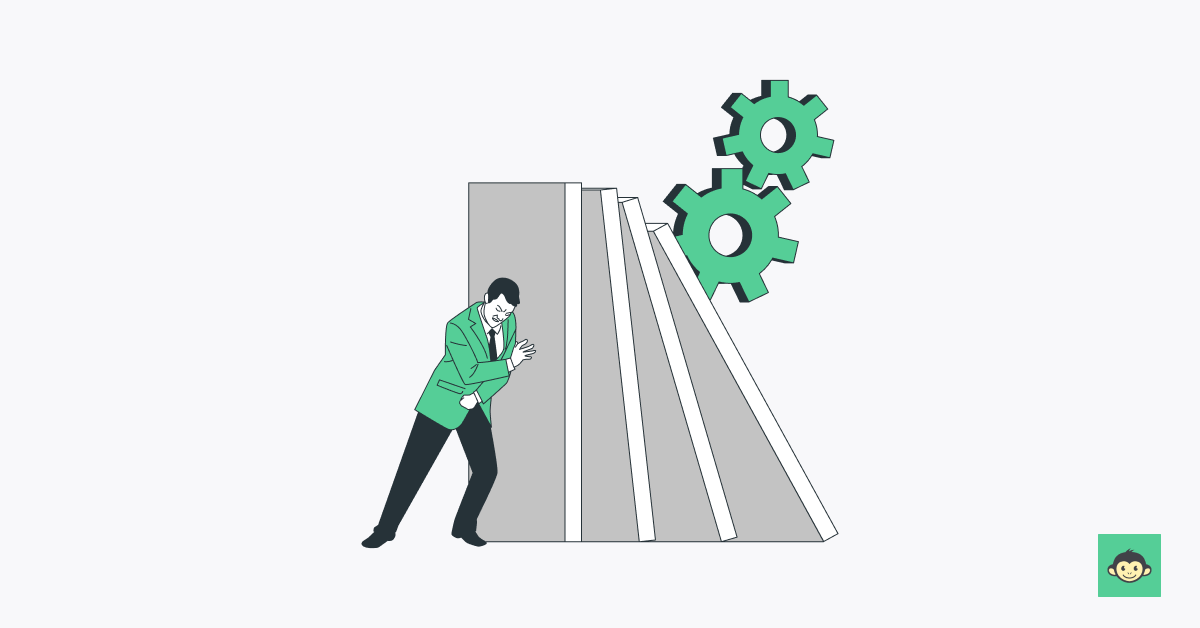What is staff retention: A complete guide to improve your retention rate at work in 2024

If you've ever felt like your office is hosting a never-ending game of musical chairs, you're not alone. But fear not! This blog is your guide to unlocking the mystical secrets of staff retention in 2024.
So, grab your metaphorical wands, because together, we're about to conjure a workplace where loyalty reigns, and the turnover spell is nothing more than a distant memory. Ready for the journey? Let's dive into the enchanting world of staff retention!
What is employee retention?

Employee retention is the art of creating an environment where team members not only choose to stay but flourish. It's a strategic dance of factors that boost employee retention that goes beyond preventing turnover.
At its core, employee retention is all about creating an atmosphere where people don't just do their job because they have to; they do it because they want to stay and become better.
Retention is a multifaceted gem, involving job satisfaction, growth opportunities, work-life balance, and a positive work environment.
Recognizing and catering to the diverse needs of your team is essential. Studies, such as one by Gallup, emphasize that engaging employees by utilizing their strengths leads to a sixfold increase in employee job satisfaction alone.
Why does employee retention matter?

So, why does it matter? Buckle up for a journey where we'll discover how it helps with saving hiring costs, getting more done, making everyone happy, and even making customers smile.
In simple terms, it's like having a crew that sticks around and makes your workplace awesome. Ready to find out why it's a big deal? Let's roll!
Financial stability
Picture your company's budget as a superhero cape—keeping employee turnover low means less spending on finding and training new folks. This superhero move, in turn, keeps your budget strong and stable. So, when your team stays, your money stays put too.
Productivity boost
Ever had a project that felt like a puzzle? Well, having a team that sticks around is like already knowing how all the pieces fit. Less time training new people means more time getting things done. It's like having a super-efficient squad that knows the drill and gets things done; count this as a good productivity boost.
Institutional knowledge
Ever played a video game and wished you had all the cheat codes? Well, long-term employees are like walking cheat codes for your company. They've got the inside scoop on how things work, which is priceless knowledge. When they stay, this valuable information stays with your organization.
Employee morale and engagement
Imagine your workplace as a happy campsite. High employee retention keeps the campfire burning bright. When people know they're sticking around, it boosts morale and engagement. It's like having a team that's not just there physically but is genuinely excited to be part of the journey.
Employer branding
Your company is like a shining beacon in the job market. A high retention rate makes it stand out. Potential hires see it as a sign that yours is a fantastic place to work. It's like having a reputation that attracts top talent, making your organization the place to be.
Leadership development
Ever had someone grow from a sidekick to a superhero? Long-term employees can do just that. When your team members stay, they have the chance to grow within the organization. This not only fills leadership roles with familiar faces but also ensures they understand the company inside out.
In essence, employee retention isn't just a good idea; it's a powerhouse move that strengthens your company's foundation, productivity, and overall success. It's like having a team of superheroes that stick together, creating a workplace where everyone wins.
Staff retention objectives one should know

A comprehensive framework is the cornerstone for building a workplace that not only retains valuable talent but propels the organization toward sustained success. Here, we delve into an in-depth exploration of key staff retention objectives, each serving as a strategic pillar in fostering stability, satisfaction, and achievement within your workplace.
Fostering a positive work environment
- Objective: Create a workplace where positivity and mutual respect thrive, forming the bedrock of a supportive and uplifting culture.
- Action steps
- Implement recognition programs that highlight and celebrate employee achievements.
- Foster open communication channels, encouraging a transparent and collaborative atmosphere.
- Cultivate team-building activities that strengthen interpersonal relationships.
Enhancing career growth opportunities
- Objective: Provide employees with clear paths for professional development and upward mobility, ensuring a sense of progression and purpose.
- Action steps:
- Offer comprehensive training programs to build and refine skill sets.
- Establish mentorship initiatives that connect experienced employees with those seeking guidance.
- Define and communicate clear career paths within the organization, outlining opportunities for advancement.
Prioritizing work-life balance
- Objective: Acknowledge and support the importance of maintaining a healthy work-life balance, promoting overall well-being.
- Action steps:
- Implement flexible work arrangements to accommodate diverse personal needs.
- Advocate for reasonable working hours, discouraging excessive overtime.
- Encourage and support employees in taking appropriate time off for rest and rejuvenation.
Recognizing and rewarding contributions
- Objective: Acknowledge and celebrate the efforts and achievements of employees, fostering a culture of appreciation.
- Action steps:
- Establish a robust recognition system that includes both formal and informal acknowledgment.
- Consider performance-based bonuses or incentives to recognize exceptional contributions.
- Regularly express appreciation for individual and team accomplishments.
Strengthening leadership and communication
- Objective: Build effective leadership and communication channels, ensuring that leaders are engaged and supportive.
- Action steps:
- Provide leadership training programs to enhance managerial skills.
- Foster transparent communication channels, keeping employees informed about organizational goals and changes.
- Ensure leaders actively engage with their teams, addressing concerns and providing guidance.
Creating a sense of belonging
- Objective: Develop a workplace where every employee feels valued and connected, promoting a sense of belonging.
- Action steps:
- Organize team-building activities that strengthen interpersonal relationships.
- Encourage cross-departmental collaboration to break down silos and promote unity.
- Implement inclusive policies that cater to diverse needs and backgrounds.
Conducting regular employee feedback and surveys:
- Objective: Continuously gauge employee satisfaction and gather feedback, fostering a culture of open communication.
- Action steps:
- Conduct regular surveys to assess employee sentiment and gather valuable insights.
- Hold feedback sessions to provide a platform for employees to express concerns and suggestions.
- Utilize feedback to make informed improvements and demonstrate a commitment to employee well-being.
Embracing diversity and inclusion:
- Objective: Foster a diverse and inclusive workplace that values and celebrates differences, contributing to a rich and innovative organizational culture.
- Action steps:
- Implement diversity training programs to promote awareness and understanding.
- Establish inclusive policies that create equal opportunities for all employees.
- Celebrate cultural awareness initiatives to build a workplace that embraces diversity.
In weaving these comprehensive objectives into your employee retention strategy, you're not merely setting goals; you're building a foundation for a workplace where employees thrive, remain engaged, and contribute to the enduring success of your organization. Each objective serves as a strategic guidepost, directing your journey toward a workplace that stands the test of time.
What does retention mean in staffing?

In simple terms, staff retention means making your workplace so awesome that people want to stay. It's not just about keeping them from leaving; it's about creating a place where everyone feels happy and wants to be a part of the team for the long haul.
So, when we talk about staff retention or retention in staffing, we're talking about creating a space where people don't just work for a paycheck; they work because they want to. It's about having a job that feels more like a favorite hobby. You know, the kind where you'd rather be at work than anywhere else.
In this journey of staff retention, we're not just dealing with job titles and desks. We're weaving a tapestry of relationships, growth, and shared victories. It's about making your workplace a sort of second home, a place where everyone feels valued, heard, and excited to be a part of something awesome.
What are the benefits of staff retention at work?

As businesses increasingly recognize the value of retaining their talented workforce, a myriad of benefits unfold, contributing to enhanced productivity, a positive work culture, and sustained growth. Let's delve into the crucial benefits that stem from fostering staff retention within the workplace.
Knowledge continuity
Retaining long-term employees ensures the preservation and seamless transfer of institutional knowledge. These seasoned individuals become invaluable during periods of organizational change, acting as guides to new processes and minimizing disruptions. Their continuity fosters a stable foundation for the entire team.
Innovation catalyst
A stable team serves as a breeding ground for innovation. Employees, feeling secure in their roles, are more likely to unleash their creative potential. The freedom to experiment without the fear of constant changes cultivates an environment where fresh ideas flourish, propelling the organization forward.
Enhanced employee well-being
Lower turnover rates contribute to improved mental health and overall well-being among employees. The stability and familiarity of the workplace create a more supportive and caring environment. As individuals feel valued and secure, the workplace becomes a space where personal and professional growth harmoniously coexist.
Consistent client relationships
Long-term employees forge enduring relationships with clients, laying the groundwork for trust and rapport. Consistency in client interactions leads to increased satisfaction and loyalty. The trust built over time becomes a valuable asset that directly impacts the organization's reputation and client retention.
Enhanced collaboration
Long-term team members develop a profound understanding of each other's strengths and weaknesses. This deep familiarity fosters enhanced collaboration and cohesion. The synergy that evolves among employees who have worked together for an extended period creates a high-functioning team that can navigate challenges seamlessly.
These nuanced benefits are the foundational advantages of staff retention. They underscore how a stable workforce contributes not only to the internal dynamics of the organization but also to its broader impact on innovation, community, and client relations. Together, these untapped rewards paint a holistic picture of workplace success.
Why are workers leaving?

Employee departures are not singular events but often woven from a tapestry of diverse factors. Understanding the complexities behind why workers and employees decide when to leave is paramount for organizations striving to enhance staff retention.
Let's explore these multifaceted reasons, each thread contributing to the narrative of why valuable team members choose to embark on new professional journeys.
Insufficient career growth opportunities
Employees are driven by a desire for continuous professional development. When they perceive limited opportunities for career growth within their current organization, the allure of exploring new horizons becomes enticing. Organizations must prioritize mentorship, training programs, and clear paths for advancement to retain ambitious talent.
Inadequate recognition and appreciation
Employees thrive on recognition for their efforts. When their contributions go unnoticed or unacknowledged, it can lead to disengagement. Organizations need to establish robust recognition programs, celebrate achievements, and ensure that employees feel valued for their hard work and dedication.
Poor work-life balance
Balancing work and personal life is crucial for employee well-being. Organizations that prioritize a harmonious work-life balance retain employees who seek not only professional success but also personal fulfillment. This involves promoting flexible work arrangements, respecting downtime, and discouraging excessive overtime.
Ineffective leadership and communication
The effectiveness of leadership directly influences employee retention. When there is a disconnect between leaders and their teams or a breakdown in communication, it erodes trust. Transparent and supportive leadership is crucial to keep employees engaged and connected to the organization's mission and vision.
Job dissatisfaction
Job dissatisfaction often stems from roles that don't align with employees' skills, interests, or aspirations. Organizations must ensure that roles are tailored to individual strengths and provide avenues for employees to contribute meaningfully. Regular feedback sessions can help align roles with employee expectations and aspirations.
Unhealthy work environment:
A toxic work environment, characterized by negativity, lack of collaboration, or unaddressed conflicts, prompts employees to seek healthier alternatives. Organizations must foster a positive and inclusive culture, address workplace conflicts promptly, and ensure that employees feel supported and valued.
By recognizing and addressing these varied reasons, organizations can proactively create strategies to enhance staff retention, turning potential departures into opportunities for growth and improvement.
What is a staff retention rate?

Understanding the concept of a staff retention rate is pivotal for organizations striving to create a workplace where talent not only thrives but also stays for the long haul. Let's unravel the intricacies of staff retention rates, exploring what they entail and why they serve as a critical metric in the realm of organizational success.
The significance of staff retention
A high staff retention rate signifies a stable and satisfied workforce, contributing to a positive work environment. Conversely, a low retention rate may signal underlying issues that demand attention, ranging from inadequate employee engagement to systemic problems within the organizational structure.
Calculating staff retention rate
The formula for calculating the staff retention rate is straightforward:
Retention Rate=(Number of Employees RemainingTotal Number of Employees at the Start)×100
Interpreting the results
A retention rate above 80% is generally considered healthy, indicating a strong connection between employees and the organization.
Rates between 70% and 80% may suggest areas for improvement in employee satisfaction and engagement.
Rates below 70% signal a red flag, warranting a thorough examination of the organizational climate and potential adjustments to retain top talent.
By comprehending the nuances of staff retention rates, organizations can harness this metric as a compass, guiding them toward a workplace where employees are not merely present but deeply invested in the shared journey of success.
How to calculate your employee retention rate?

Calculating your employee retention rate is akin to decoding the health of your organizational ecosystem. This key metric provides valuable insights into the stability and satisfaction levels of your workforce. Let's demystify the process, offering a step-by-step guide to help you effortlessly determine and understand your employee retention rate.
Define your time period
Begin by selecting a specific time frame for your calculation. Whether you choose a quarterly, semi-annual, or annual basis depends on your organizational goals and the frequency of changes in your workforce.
Identify the starting and ending employee count
At the beginning of the chosen period, note the total number of employees. Similarly, at the end of the period, tally the remaining workforce. This provides the baseline data needed for the calculation.
Determine the number of departures
During the designated period, count the number of employees who left the organization. This includes resignations, retirements, and any other forms of employment termination.
Interpret the results
- A retention rate above 80% typically indicates a healthy work environment with satisfied employees.
- Rates between 70% and 80% suggest room for improvement in terms of employee satisfaction and engagement.
- Rates below 70% signal a potential issue that demands a closer look at organizational dynamics and potential areas for enhancement.
Leverage benchmarking
Compare your retention rate with industry benchmarks to gain a broader perspective. Understanding how your organization fares in comparison can guide targeted improvements.
By embracing a systematic approach to calculating your employee retention rate, you empower your organization to proactively address workforce dynamics, foster a positive environment, and pave the way for sustained success.
Employee retention vs employee turnover
In the intricate realm of both human resource management and resources, distinguishing between employee retention and employee turnover is crucial for organizational success.
While both terms revolve around workforce dynamics, they signify distinct facets of the employee lifecycle. Let's delve into the nuances, exploring the differences and implications that these two metrics hold for your organization.
Employee retention: unveiling workplace loyalty
Employee retention is the art and science of keeping valuable team members within the organizational fold. It encapsulates strategies and initiatives aimed at fostering a positive work environment, aligning employee goals with organizational objectives, and nurturing long-term commitments.
A high retention rate signifies a stable, satisfied workforce, contributing to a harmonious workplace culture.
Employee turnover: deciphering departures
On the flip side, employee turnover represents the rate at which employees quit an organization within a specified time frame. It encompasses both voluntary departures, such as resignations, and involuntary departures, such as terminations.
Understanding turnover is vital to pinpoint areas of improvement, identify potential challenges, and address the factors influencing employee exits.
Key differences:
- Perspective: Retention focuses on nurturing existing talent, emphasizing engagement and satisfaction. Turnover, on the other hand, revolves around analyzing departing employee, understanding why they choose to leave, and implementing strategies to mitigate turnover risks.
- Longevity vs. departures: Retention is concerned with creating an environment where employees choose to stay for the long term. Turnover, conversely, zooms in on the departure patterns, providing insights into the reasons behind employee exits.
- Proactive vs. reactive: Retention strategies are proactive, aiming to create conditions that encourage employees to stay. Turnover analysis is reactive, addressing departures after they occur to prevent future losses.
Implications for organizations:
- Retention impact: organizations with a strong focus on retention often enjoy benefits such as enhanced productivity, positive workplace culture, and a competitive edge in talent acquisition.
- Turnover insights: understanding turnover provides organizations with valuable insights into potential areas for improvement. It helps in identifying patterns, addressing issues, and ultimately reducing the negative impact of employee departures.
- Striking a balance: Successful organizations recognize the symbiotic relationship between retention and turnover. While prioritizing retention is essential for cultivating a loyal workforce, effectively managing turnover ensures that departures are not only minimized but also leveraged as opportunities for growth and improvement.
- Continuous evaluation: The HR landscape is dynamic, and the interplay between employee retention and turnover evolves. Regularly assessing both metrics allows organizations to adapt strategies, fostering an environment where employees not only stay but thrive in alignment with the organization's vision.
By comprehending the distinctions between employee retention and the employee turnover rate, organizations can craft holistic HR strategies that prioritize both the longevity of their workforce and the insightful management of employee departures.
7 Staff retention challenges one should know about

As organizations traverse the ever-changing landscape of talent management, they encounter an array of challenges that directly influence staff retention. These challenges, though formidable, serve as compass points guiding leaders toward opportunities for improvement and growth. In this exploration, we unravel seven key staff retention challenges, each presenting a unique puzzle to solve.
- Evolving work dynamics: As the nature of work transforms, embracing remote setups, flexible schedules, and dynamic job structures, organizations face the challenge of aligning their retention strategies with these evolving dynamics. Adapting to the changing expectations of modern employees is essential to retaining top talent.
- Leadership transition gaps: Leadership changes can create uncertainty and affect the organizational climate. During these transitions, maintaining clear communication, fostering stability, and ensuring that the new leadership aligns with the company's values are crucial for staff retention.
- Skills development and training gaps: In a rapidly evolving professional landscape, employees value continuous learning and development. Organizations grappling with inadequate training programs or insufficient opportunities for skill enhancement risk losing employees seeking avenues for professional growth.
- Diversity and inclusion challenges: Fostering a diverse and inclusive workplace is not only a moral imperative but also crucial for staff retention. Organizations that fail to create an inclusive environment may face challenges retaining diverse talent, impacting overall employee satisfaction.
- Burnout and well-being concerns: The modern workplace often treads a fine line between productivity and employee well-being. Organizations that neglect the importance of a healthy work-life balance may witness increased burnout, negatively impacting staff retention. Implementing well-being initiatives is essential for increased employee retention, satisfaction and longevity.
- Compensation misalignment: A significant challenge arises when employee compensation does not align with industry standards or the perceived market value of skills. Addressing compensation gaps and ensuring a fair and competitive salary structure is crucial for retaining top talent.
- Lack of recognition and appreciation: Employees who feel undervalued or underappreciated are more likely to seek opportunities elsewhere. Organizations that neglect to establish robust recognition programs, celebrate achievements, and express appreciation risk losing valuable team members.
Each of these challenges presents an opportunity for organizations to evolve and enhance their staff retention strategies. Implementing transparent communication, prioritizing employee well-being, health and safety protocols aligning leadership transitions with the company's vision are steps towards creating a workplace where employees not only stay but thrive.
Navigating these challenges requires a proactive and holistic approach, where organizations continuously assess their strategies, adapt to changing dynamics, and foster an environment that promotes both individual and collective success.
5 Retention mistakes employers make
While the pursuit of staff loyalty is a noble endeavor, certain common mistakes can inadvertently undermine these efforts. Join us as we uncover five retention pitfalls frequently encountered by employers. By shedding light on these missteps, we aim to equip organizations with the knowledge needed to navigate the complexities of staff retention more effectively.
- Neglecting employee well-being: A common pitfall is underestimating the impact of employee well-being on retention. Failing to prioritize work-life balance and mental health initiatives can lead to burnout and dissatisfaction. Employers must recognize the importance of holistic well-being, implementing policies that support a healthy balance between professional and personal life.
- Inadequate recognition and appreciation: Overlooking the need for regular recognition and appreciation is a retention mistake that can have profound consequences. Employees who feel undervalued are more likely to seek opportunities elsewhere. Employers should establish robust recognition programs, celebrate achievements, and foster a culture where every contribution is acknowledged.
- Limited opportunities for growth: A lack of emphasis on professional development and growth opportunities can drive talented individuals away. Employees seek organizations that invest in their continuous learning and skill enhancement. Employers should provide avenues for career progression, mentorship programs, and ongoing training to demonstrate a commitment to employee growth.
- Compensation misalignment: One of the most significant retention mistakes is neglecting to align compensation with industry standards and employee expectations. When employees perceive a significant gap between their compensation and market value, they may explore alternatives offering more competitive pay packages. Regular salary reviews and market benchmarking are crucial to retaining top talent.
- Poor communication and transparency: Insufficient communication and transparency create an environment of uncertainty, eroding trust and engagement. Employees desire clarity about organizational goals, changes, and their roles in the broader context. Employers should prioritize transparent communication, keeping employees informed and involved in the decision-making process.
Recognizing and rectifying these missteps positions employers on a path toward a workplace where employees not only stay but thrive. By learning from these challenges, organizations can proactively shape a future where staff retention is not just a goal but a natural outcome of a supportive, engaging, and forward-thinking workplace.
Staff retention KPIs to measure and improve retention at work
Navigating the nuances of staff retention requires a keen understanding of key performance indicators that serve as barometers for employee loyalty. These KPIs provide valuable insights into the health of your workforce, offering a nuanced perspective beyond turnover rates. Let's explore the crucial KPIs that organizations should measure to gauge, enhance, and optimize their staff retention efforts.
Retention rate
The fundamental metric, retention rate, calculates the percentage of employees who remain with the organization over a specific period. A high retention rate signifies a stable and satisfied workforce, while a lower rate may indicate areas for improvement in engagement and satisfaction.
Turnover cost:
Understanding the financial impact of turnover is essential. Turnover cost KPI encompasses recruitment expenses, training costs for new hires, and the productivity loss during the transition period. Monitoring this KPI provides insights into the financial implications of employee departures.
Average employee tenure:
Tracking the average tenure of employees provides a snapshot of the organization's ability to retain talent. A longer average tenure is often indicative of a positive workplace culture and effective retention strategies.
These metrics not only serve as indicators of past performance but also guide organizations in shaping future retention strategies. By consistently measuring and optimizing these KPIs, organizations can forge a workplace where loyalty thrives, contributing to sustained success and growth.
15 Creative and effective employee retention strategies to use in 2024

As we step into 2024, the traditional playbook of retention strategies may need a refreshing update. This exploration dives into 15 creative and effective employee retention strategies poised to make a significant impact on organizational culture, engagement, and overall retention in the contemporary professional landscape.
- Flexible work arrangements: Embrace flexibility by offering remote work options, flexible hours, or compressed workweeks. Catering to diverse work styles enhances job satisfaction and work-life balance.
- Personalized development plans: Tailor development plans to individual career aspirations, providing employees with a roadmap for growth within the organization.
- Mentorship programs: Cultivate a culture of learning and growth through mentorship programs, fostering relationships cultivate a culture of learning and growth through mentorship programs, fostering relationships that contribute to professional development and engagement contribute to professional development and engagement.
- Employee recognition platforms: Implement digital recognition platforms that enable peers and supervisors to acknowledge and celebrate achievements, fostering a culture of appreciation.
- Well-being initiatives: Prioritize employee well-being with initiatives such as wellness programs, mental health support, and activities that promote a healthy work-life balance.
- Cross-functional training: Encourage cross-functional training to broaden skill sets and provide employees with a more comprehensive understanding of the organization.
- Inclusive decision-making: Foster inclusivity by involving employees in decision-making processes, ensuring diverse perspectives contribute to organizational strategies.
- Internal mobility programs: Facilitate internal mobility, allowing employees to explore different roles and departments, fostering a sense of career variety and growth.
- Continuous feedback loops: Replace traditional performance reviews with continuous feedback loops, promoting regular communication and addressing concerns in real-time.
- Cultivate a positive work environment: Foster a positive workplace culture by prioritizing collaboration, open communication, and creating spaces where employees feel valued and supported.
- Purpose-driven initiatives: Align organizational goals with meaningful initiatives that resonate with employees, reinforcing a sense of purpose in their work.
- Flexible benefits packages: Tailor benefits packages to accommodate diverse needs, allowing employees to choose perks that align with their lifestyles.
- Social connection activities: Organize team-building activities, virtual or in-person, to strengthen social connections and create a sense of camaraderie among team members.
- Innovative recognition rewards: Introduce unique and personalized recognition rewards, such as experiences or professional development opportunities, to make acknowledgment more impactful.
- Leadership development programs: Invest in leadership development programs to groom internal talent, ensuring a pipeline of capable leaders and signaling a commitment to employee growth.
As organizations step into 2024, the power of innovative employee retention strategies becomes a key driver in fostering commitment and engagement. By embracing these creative approaches, organizations can not only retain valuable talent but also cultivate a workplace where employees thrive, contributing to sustained success and a dynamic organizational culture.
How does employee retention fit into your employee experience (EX) strategy?
While discussing employee experience (EX) strategies, employee retention is not merely a thread but a fundamental weave that holds the entire fabric together. Understanding how employee retention seamlessly integrates into your EX strategy is key to creating a workplace where employees not only have positive experiences but also choose to stay and contribute to the organization's success.
- Cohesive cultural alignment: Employee retention and a strong company culture go hand in hand. Integrating retention efforts into your EX strategy ensures that the organizational culture aligns with the values and expectations of employees. A cohesive cultural fit enhances the overall employee experience, fostering a sense of belonging and commitment.
- Continuous development opportunities: A robust EX strategy prioritizes continuous learning and development. By incorporating employee retention initiatives, organizations signal a commitment to providing growth opportunities. This not only enhances the employee experience but also contributes to long-term engagement and satisfaction.
- Seamless onboarding and integration: The employee experience begins with onboarding. Integrating retention elements into the onboarding process ensures that new hires feel welcome, understand their role in the organization, and are set on a path toward long-term success and commitment.
- Flexible work practices for well-being: Employee well-being is a crucial aspect of a positive EX. Including flexible work practices and work-life balance initiatives in your strategy demonstrates a commitment to the holistic well-being of employees, contributing to their overall experience and, consequently, their likelihood to stay.
- Leadership as experience architects: Leadership plays a pivotal role in shaping the employee experience. Training leaders to prioritize employee retention as part of their leadership style ensures that they become architects of positive experiences, setting the tone for a workplace where employees feel supported and engaged.
By weaving employee retention seamlessly into your EX strategy, organizations create a holistic and sustainable approach to improve employee retention and engagement. This integration enhances not only the overall experience but also establishes a workplace culture where employees are motivated to stay, grow, and actively contribute to the organization's success.
Conclusion
In our exploration of staff retention strategies, we've uncovered the keys to fostering workplace loyalty and success. As you navigate the dynamic terrain of employee experience, remember that retention is a continuous journey, not just a destination. Explore tailored solutions at CultureMonkey. Transform your workplace into a haven of loyalty and achievement in 2024 and beyond.



